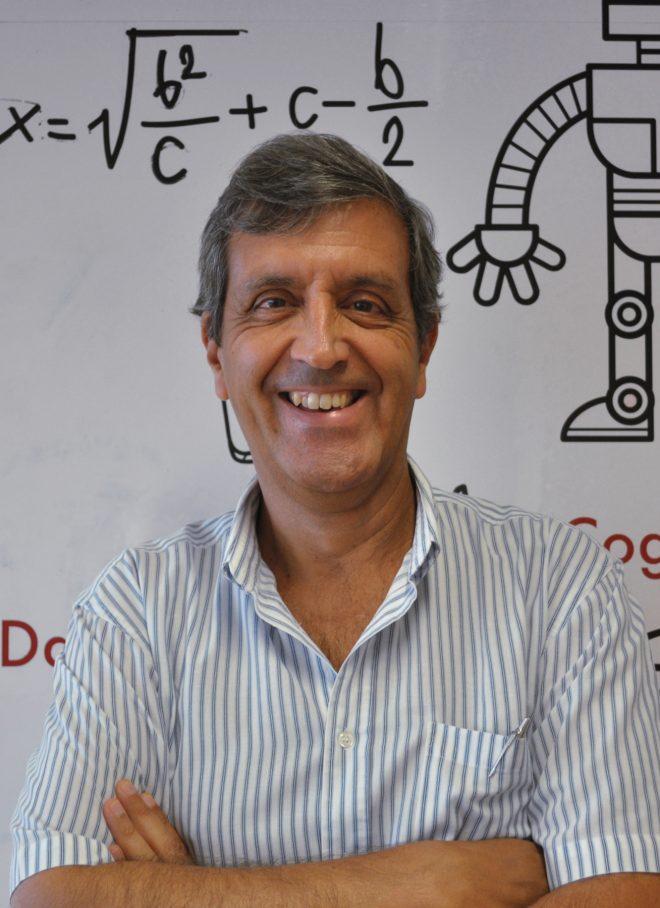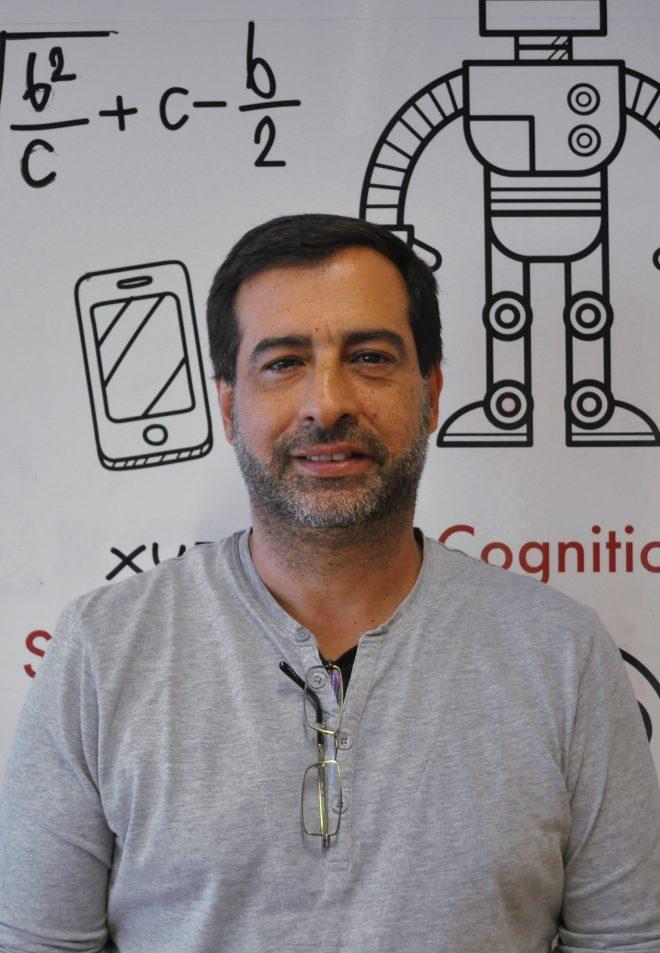| Acronym | SocRob |
|---|---|
| Name | Society of Cooperative Robots |
| Funding Reference | FCT - POSI/ROBO/43900/2002 |
| URL | http://socrob.isr.ist.utl.pt |
| Dates | 1997| |
| Summary | This project fosters general research on multi-agent robotic systems, aiming at introducing methodologies for task planning, task allocation and teamwork supervision/coordination, driven by results from Distributed AI, Hybrid Systems and Discrete Event Systems theory. Its current case study is on Soccer Robots, with regular participations in RoboCup. |
| Research Groups |
Intelligent Robots and Systems Group (IRSg) |
| Project Partners | IdMind, ServiLog |
| ISR/IST Responsible | |
| People |
[1] Rodrigo Ventura, Pedro Aparicio, Luís Custódio, Pedro Lima, "A Functional Architecture for a Team of Fully Autonomous Cooperative Robots", in Manuela Veloso and Hiroaki Kitano, editors, RoboCup-99: Robot Soccer World Cup III, Lecture Notes in Computer Science, Springer-Verlag, Berlin, (12 pags), 2000 - PDF
[2] Rodrigo Ventura, Pedro Aparicio, Carlos Marques, Pedro Lima, Luís Custódio, "ISocRob – Intelligent Society of Robots", in Manuela Veloso and Hiroaki Kitano, editors, RoboCup-99: Robot Soccer World Cup III, Lecture Notes in Computer Science, Springer-Verlag, Berlin, 2000 - PDF
[3] Carlos Marques, Pedro Lima, "Vision-Based Self-Localization for Soccer Robots", in Proceedings of IEEE/RSJ International Conference on Intelligent Robots and Systems - IROS2000, (6 pages), Takamatsu , Japan , 2000 - PDF
[4] Rodrigo Ventura, Filipe Toscano, Carlos Marques, Luís Custódio, Pedro Lima, "ISocRob-2000: technical report", ISR Technical Report RT-701-00, RT-402-00, 2000 - PDF
[5] C. Marques, Pedro Lima, "A Localization Method for a Soccer Robot Using a Vision-Based Omni-Directional Sensor", in RoboCup 2000 Book, Springer-Verlag, Berlin, 2001 - PDF
[6] Pedro Lima, Andrea Bonarini, Carlos Machado, Fabio Marchese, Carlos Marques, Fernando Ribeiro, Domenico Sorrenti, "Omni-Directional Catadioptric Vision for Soccer Robots", Special issue on the EuroRoboCup of the Journal of Robotics and Autonomous Systems, Elsevier, Amesterdam, Vol 36, no 2, 2001 - PDF
[7] M. Asada, T. Balch, R. DAndrea, M. Fujita, B. Hengst, G. Kraetzschmar, Pedro Lima, N. Lau, H. Lund, D. Polani, P. Scerri, S. Tadakoro, T. Weigel, G. Wyeth, "RoboCup-2000: The Fourth Robotic Soccer World Championships", AI-Magazine, Vol. 22, No. 1, 2001 - PDF
[8] H.-D. Burkhard, D. Duhaut, M. Fujita, Pedro Lima, R. Murphy, R. Rojas, "Towards a Research RoadMap for RoboCup", IEEE Robotics and Automation Magazine, Vol. 9, No. 2, 2002
[9] Pedro Lima, T. Balch, M. Fujita, R. Rojas, M. Veloso, H. Yanco, "The RoboCup 2001 Competitions and Conference: Report and Research Issues", IEEE Robotics and Automation Magazine, Vol. 9, No. 2, 2002
[10] C. Marques, Pedro Lima, "Multi-Sensor Navigation for Soccer Robots.", Proc. RoboCup 2001 Workshop, Seattle, USA, 2002
[11] C. Marques, Pedro Lima, "Multi-Sensor Navigation for Soccer Robots", RoboCup 2001 Book, Springer-Verlag, Berlin, 2002 - PDF
[12] Bruno Damas, Luís Custódio, Pedro Lima, "A Modified Potential Fields Method for Robot Navigation Applied to Dribbling in Robotic Soccer", Proc. of RoboCup Symposium, Fukuoka, Japan, 2002 - PDF
[13] Bruno Damas, Pedro Lima, Luís Custódio, "Navegacao Entre Obstaculos Usando Um Metodo de Campos de Potencial Modificados", Actas do Encontro Cientifico do Robotica 2002 - Festival Nacional de Robotica, 2002 - PDF
[14] Pedro Lima, Luís Custódio, "Artificial Intelligence and Systems Theory Applied to Cooperative Robots: the SocRob Project", Actas do Encontro Cientifico do Robotica 2002 - Festival Nacional de Robotica, 2002 - PDF
[15] Bruno Damas, Luís Custódio, Pedro Lima, "A Modified Potential Fields Method for Robot Navigation Applied to Dribbling in Robotic Soccer", RoboCup 2002 Book, Editors: Gal Kaminka, Pedro Lima and Raul Rojas, Springer-Verlag, Berlin, 2003
[16] Gonçalo Neto, Hugo Costelha, Pedro Lima, "Topological Navigation in Configuration Space Applied to Soccer Robots", Proc. RoboCup 2003 International Symposium, Padova, Italy, 2003 - PDF
[17] Carla Penedo, João Pavão, Pedro Nunes, Luís Custódio, "RoboCup Advanced 3D Monitor", RoboCup 2003 International Symposium, Padova, Italy, 2003 - PDF
[18] Hans Lausen, Jakob Nielsen, Michael Nielsen, Pedro Lima, "Model and Behavior – Based Robotic Goalkeeper", Proc. RoboCup 2003 International Symposium, Padova, Italy, 2003 - PDF
[19] Miguel Arroz, Vasco Pires, Luís Custódio, "Logic based Distributed Decision System for a Multi-Robot Team", Proc. ROBOTICA2003 - 3rd Portuguese Robotics Festival, Lisbon, Portugal, 2003 - PDF
[20] Carla Penedo, João Pavão, Pedro Lima, Isabel Ribeiro, "Markov Localization in the RoboCup Simulation League", Proc. ROBOTICA2003 - 3rd Portuguese Robotics Festival, Lisbon, Portugal, 2003 - PDF
[21] Pedro Marcelino, Pedro Nunes, Pedro Lima, Isabel Ribeiro, "Improving object localization through sensor fusion applied to soccer robots", Proc. ROBOTICA2003 - 3rd Portuguese Robotics Festival, Lisbon, Portugal, 2003 - PDF
[22] Gonçalo Neto, Hugo Costelha, Pedro Lima, "Topological Navigation in Configuration Space Applied to Soccer Robots", RoboCup-2003: Robot Soccer World Cup VII, Springer Verlag, Berlin, 2004
[23] Pedro Lima, H. Lausen, J. Nielsen, M. Nielsen, "Model and Behavior-Based Robotic Goalkeeper", RoboCup-2003: Robot Soccer World Cup VII, Springer Verlag, Berlin, 2004
[24] Carlos Marques, Pedro Lima, "Multi-Sensor Navigation for Non-Holonomic Robots in Cluttered Environments", IEEE Robotics and Automation Magazine, Vol. 11, No. 3, 2004
[25] Vasco Pires, Miguel Arroz, Luís Custódio, "Logic Based Hybrid Decision System for a Multi-robot Team", Proc. 8th Conference on Intelligent Autonomous Systems, Amsterdam, The Netherlands, 2004 - PDF
[26] Bruno Damas, Pedro Lima, "Stochastic Discrete Event Model of a Multi-Robot Team Playing an Adversarial Game", Proc. IAV 2004 - 5th IFAC/EURON Symposium on Intelligent Autonomous Vehicles, Lisbon, Portugal, 2004 - PDF
[27] Bob van der Vecht, Pedro Lima, "Formulation and Implementation of Relational Behaviours for Multi-Robot Cooperative Systems", Proc. RoboCup 2004 Symposium, Lisbon, Portugal, 2004 - PDF






